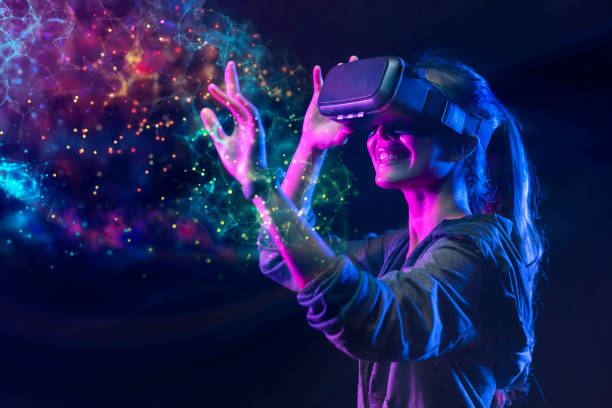Augmented Reality (AR) has emerged as one of the most exciting technological innovations of the 21st century. While its early uses were confined mostly to niche applications in research, military technology, and entertainment, AR has evolved into a widespread technology that is reshaping numerous industries. Today, from smartphones to sophisticated AR glasses, the integration of digital content with the real world is providing users with new and innovative ways to interact with their environment. But what exactly is Augmented Reality, and why is it such a powerful tool?
This article delves deeply into what AR is, tracing its history, exploring the key technologies behind it, and examining its current and future applications across various fields. Along the way, we will discuss how AR has already started to influence our everyday lives and where it might take us in the future. The journey into the world of AR is a thrilling one—let’s explore it together.
Defining Augmented Reality: A New Lens on the World
At its most fundamental level, Augmented Reality is a technology that overlays digital content—whether that be images, sounds, or data—onto the real world, enhancing a person’s perception of their surroundings. Unlike Virtual Reality (VR), which immerses users in a fully artificial environment, AR works by merging real-world elements with computer-generated ones, creating an interactive and enriched experience. This allows the user to see the world around them in a completely new way, enhanced with virtual information that can interact with the real world.
While Virtual Reality takes users to an entirely different, computer-generated world, Augmented Reality keeps users grounded in the real world while adding layers of information on top. Imagine walking through a city and seeing virtual signs pointing to nearby attractions or walking through a museum where digital artifacts come to life when viewed through an AR device. The experience is not limited to a screen but expands into your surroundings, offering a richer, more immersive interaction with the world.
The Origins of Augmented Reality: A Technology Born from Visionary Ideas
The history of Augmented Reality is far longer and more intricate than one might think. While it feels like a recent technological advancement, the seeds of AR were planted over 50 years ago, when computing and electronics were still in their infancy. One of the earliest concepts of AR emerged in the 1960s, thanks to the visionary work of Ivan Sutherland, a computer scientist and engineer. His creation, the “Sword of Damocles,” is often regarded as one of the earliest AR systems, though it was rudimentary by today’s standards. The device was essentially a head-mounted display (HMD) that presented simple wireframe graphics to the user. Although this was a basic prototype, it laid the foundation for future developments in AR.
In the 1990s, the term “Augmented Reality” was coined by Tom Caudell, who was working on a project at Boeing to assist workers in assembling airplanes. The idea was to display digital information, such as diagrams and instructions, directly in the worker’s line of sight, which helped reduce errors and improve efficiency. This concept of augmenting the real world with digital overlays quickly gained traction in various industries, and as computing power increased in the following decades, AR began to evolve rapidly.
The Key Technologies Behind Augmented Reality
To truly understand how AR works, it’s important to explore the technologies that make it possible. Augmented Reality is a complex fusion of hardware and software, with many different components working together in real-time to create an immersive experience. These components include cameras, sensors, displays, and advanced algorithms that analyze and interpret the user’s environment. Let’s break down some of the critical technologies behind AR.
Hardware: Devices and Sensors
At the heart of every AR experience is hardware that allows the user to see the world and interact with digital content. The most common AR devices today are smartphones and tablets, but AR can also be experienced through specialized devices like smart glasses or AR headsets. These devices are equipped with a variety of sensors, such as cameras, accelerometers, gyroscopes, and GPS modules, which help capture the real-world environment and track the user’s movements and orientation.
- Cameras play a crucial role in AR by capturing real-time video footage of the user’s environment. This footage forms the foundation for the AR experience, as digital content is superimposed onto the live video stream.
- Sensors, such as accelerometers and gyroscopes, detect the movement and orientation of the device, allowing the system to adjust the placement and interaction of digital objects based on the user’s actions.
- GPS is another essential sensor for location-based AR experiences. It helps the device determine where the user is located and provides context for spatially aware AR applications, such as navigation or location-based gaming.
- Displays are the medium through which users view the augmented world. Whether through a smartphone screen, smart glasses, or AR headsets, the display is where the magic happens, showcasing both the real world and the digitally enhanced elements.
Software: The Brain Behind the Experience
While the hardware captures and processes environmental data, the software is what makes sense of this information and generates the augmented experience. The software typically includes several components, such as computer vision, spatial mapping, and 3D rendering, that allow the AR system to understand the user’s surroundings and overlay digital content in a way that feels natural.
- Computer Vision enables the device to “see” and understand the environment. This can involve object recognition, where the software identifies and tracks specific objects in the real world, as well as surface detection, which helps the system place digital content on real-world surfaces like tables, walls, or floors.
- Spatial Mapping allows AR systems to create a 3D map of the environment, which is essential for accurately placing virtual objects. This technology ensures that the digital content aligns properly with the physical world and moves naturally as the user interacts with it.
- 3D Rendering is what allows digital content—whether it’s a simple graphic or a complex 3D model—to be displayed in the AR environment. This requires high-performance graphics processing to ensure that the virtual content looks realistic and is rendered in real-time as the user moves.
Interaction and User Experience
What sets AR apart from other technologies is its interactivity. Unlike traditional media, where the user is a passive observer, AR enables active engagement with digital content. AR systems can respond to user inputs, whether through touch, gestures, voice commands, or even eye tracking. For instance, users might tap on a virtual object to resize it, swipe to change its position, or speak to get information about a particular item.
As AR technologies evolve, we are likely to see even more advanced forms of interaction. For example, researchers are working on integrating brain-computer interfaces (BCIs) with AR systems, allowing users to control virtual elements using nothing but their thoughts. This type of seamless, intuitive interaction could revolutionize the way we use AR in the future.
The Evolution of Augmented Reality in Consumer and Business Applications
Over the years, AR has transitioned from a niche technology to a mainstream tool, gaining traction in both consumer and business applications. The evolution of AR can be traced through a few key milestones, each marking significant advancements in how AR is used and experienced.
Early Beginnings: Military and Industrial Applications
In its early days, AR was mostly confined to specialized applications, such as military training, aviation, and industrial settings. The U.S. military, for instance, used AR to provide soldiers with heads-up displays (HUDs) that showed critical information during combat. Similarly, AR systems were developed for pilots to display flight data and navigation information directly in their line of sight, allowing for more efficient and safer operations.
In the industrial sector, AR was used for maintenance, assembly, and training. Engineers could use AR to visualize complex machinery and receive step-by-step guidance for assembly or repairs. These early applications proved that AR could improve efficiency and accuracy in highly technical fields, setting the stage for broader adoption.
The Rise of Consumer AR: Smartphones and Entertainment
The advent of smartphones with built-in cameras and powerful processors opened the door for consumer-facing AR applications. With the introduction of apps like Pokémon GO in 2016, AR suddenly became a global sensation, capturing the imaginations of millions of people. Pokémon GO used location-based AR to allow players to catch virtual creatures that appeared in real-world environments, leading to a massive wave of engagement and media coverage.
The success of Pokémon GO proved that AR could be more than just a tool for businesses and industries—it could also be a source of entertainment and social interaction. Since then, AR has continued to grow in popularity in the consumer space, with apps for social media filters (like Snapchat and Instagram), virtual shopping, and even education.
AR in Business: Transforming Industries
Beyond entertainment, AR has found a home in a wide range of business applications. Companies across various industries are leveraging AR to improve customer experiences, enhance productivity, and optimize processes.
- Retail: In retail, AR is revolutionizing the way customers shop. Through AR apps, customers can virtually try on clothes, visualize how furniture will look in their homes, or test out new products before making a purchase. These experiences offer a more personalized shopping journey and increase customer engagement.
- Education and Training: AR is being used in schools, universities, and corporate training environments to enhance learning experiences. Instead of relying on textbooks and static visuals, students can interact with 3D models, explore complex scientific concepts, and engage in immersive, hands-on experiences. This technology has proven to be especially effective in fields like medicine, where students can simulate surgeries or explore the human anatomy in great detail.
- Healthcare: In healthcare, AR is making a significant impact by assisting with surgical procedures, providing real-time information during diagnoses, and improving patient care. Surgeons can overlay vital data, such as patient imaging or medical records, onto the patient’s body during operations, ensuring precision and minimizing errors.
- Architecture and Real Estate: In architecture and real estate, AR allows designers and potential buyers to visualize buildings, homes, and properties before construction begins. By overlaying digital blueprints and 3D models onto physical spaces, AR gives clients a more realistic sense of scale and design, helping them make more informed decisions.
The Future of Augmented Reality: What Lies Ahead
The future of AR is undeniably exciting, with advancements in hardware, software, and artificial intelligence paving the way for even more immersive and sophisticated experiences. As AR continues to mature, we can expect to see it become an integral part of our everyday lives.
One of the most anticipated developments is the evolution of AR hardware. While smartphones and tablets remain the dominant devices for AR, AR glasses and headsets are expected to become the go-to platforms in the coming years. These devices, which will be lightweight, comfortable, and more powerful, will allow users to seamlessly interact with augmented content without the need for a handheld device. Companies like Apple, Google, and Microsoft are already investing heavily in AR glasses, and it’s only a matter of time before these devices become mainstream.
Additionally, the integration of AR with other emerging technologies, such as 5G, AI, and the Internet of Things (IoT), will enable new and more complex AR experiences. For example, 5G networks will provide the high-speed connectivity necessary to stream real-time AR content with minimal lag, while AI will make AR systems smarter and more personalized.
As AR technology becomes more pervasive, we may see entire industries transform as a result. Education, entertainment, healthcare, retail, and many others will continue to be enhanced by AR, opening up new possibilities for how we learn, shop, work, and play. Whether it’s a virtual assistant guiding you through your daily tasks or a digital layer transforming your living room into a movie theater, the potential for AR is limitless.
Conclusion: Augmented Reality’s Transformative Potential
Augmented Reality is not just a passing trend—it is a transformative technology that is reshaping our world in real time. From its humble beginnings in military and industrial applications to its current role in entertainment, education, healthcare, and beyond, AR has proven to be a versatile and powerful tool. As technology continues to advance, the line between the digital and physical worlds will blur even further, creating richer, more interactive experiences that enhance our daily lives.
As we look to the future, AR’s potential appears boundless. The possibilities for how AR can revolutionize industries, improve productivity, and create new forms of entertainment and social interaction are exciting and ever-expanding. The question is no longer if AR will change the world, but how—and how soon.






